Menu
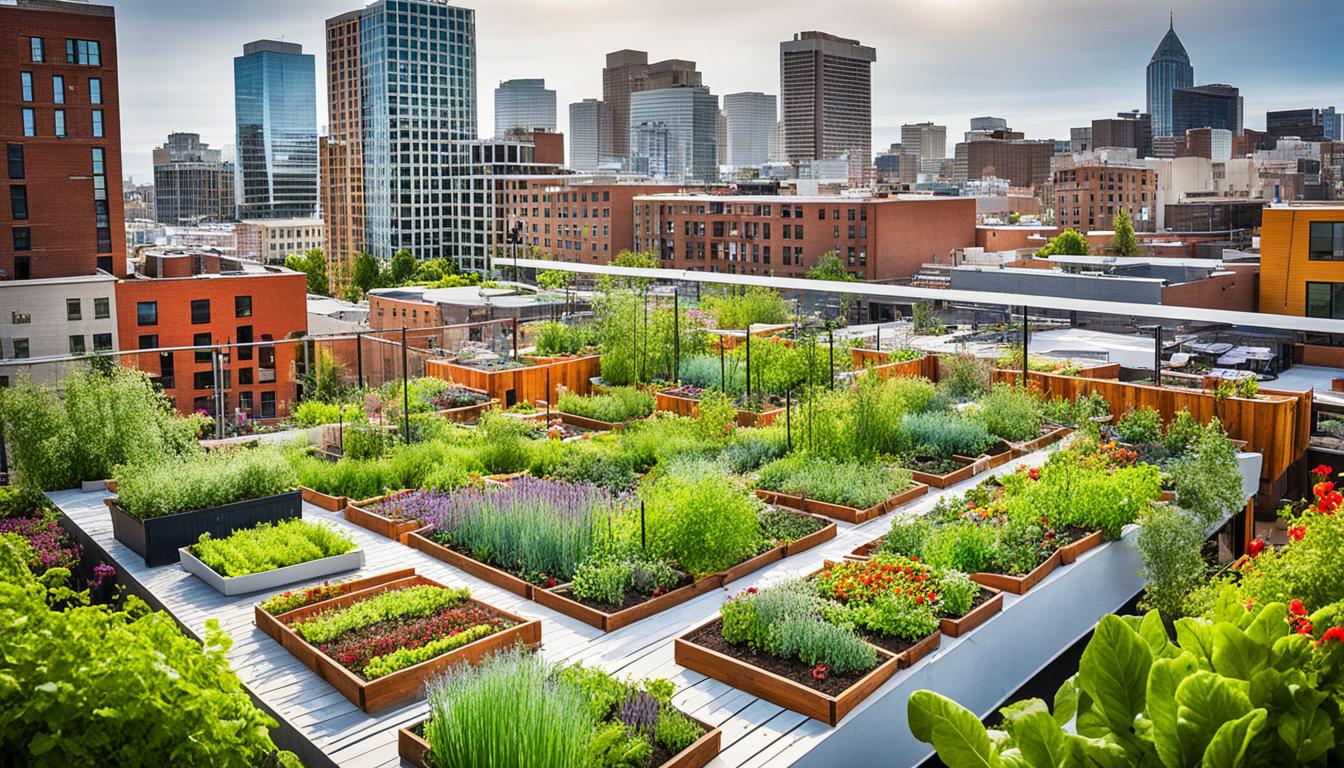
Did you know that in 1944, gardens at home and in communities supplied about 40% of the food? They did this during wartime. This fact shows how local food can make a big difference, especially in cities. Today, urban organic farming offers a way to grow food that’s ecological and fits our crowded cities. It follows the ideas of Sir Albert Howard, connecting the health of the soil, plants, animals, and people.
The need for urban organic farming is bigger now because of the issues with industrial farming. Industrial farming was a big deal in the 20th century. Now, we’re combining old farming wisdom with new tech. This way, we’re making cities greener, and we’re helping the planet. This path we’re on supports food growing that is good for the environment, makes sense financially, and is ethical.
Urban organic farming is gaining popularity as an alternative to big industrial farms. Many see it as a way to live sustainably in our cities. This approach focuses on using eco-friendly methods and producing food locally. More than 800 million people around the globe are now part of this movement, with 266 million families in developing countries growing their own food.
City farming takes many forms, from gardens on rooftops to shared community spaces. For instance, in Asia, over 182 million homes are growing crops in their cities. In Europe, there are about 15 million urban farming households. A big advantage of city farming is that it can produce a lot in a small space. Some places report getting up to 50 kg of fruits and veggies from each square meter every year.
Certain crops like rice, wheat, and maize do well in parts of cities with planned water systems. But in places that rely on rain to water their crops, they tend to grow wheat, maize, and feed for animals. All across the world, cities have over 67 million hectares of land where they grow crops. This includes places both with and without special water systems. This shows that even in smaller or less dense cities, urban farming can make a big impact.
In the move towards sustainable city life, the role of organic farming is key. This kind of farming is done on about 70 million hectares in 130 countries globally. It makes up 90% of sales in major markets, like the US and EU. But, it also usually produces less food per area than big farms do. This is a challenge, but it’s also a space for new ideas in farming in the city.
Urban organic farming not only helps feed us now, but it also looks towards the future. By choosing local and sustainable ways to grow food, city farming is changing how we think about producing what we eat. This helps to protect our planet and build stronger communities.
To wrap it up, city farming and organic food are vital for our urban future. They offer a real solution to the problems of big industrial farming. This way, we can aim for a healthier planet and lifestyle.
Urban agriculture dates back to ancient times, growing alongside early civilisations. As cities grew, so did the need for local food sources. This led to a tradition of farming in urban areas.
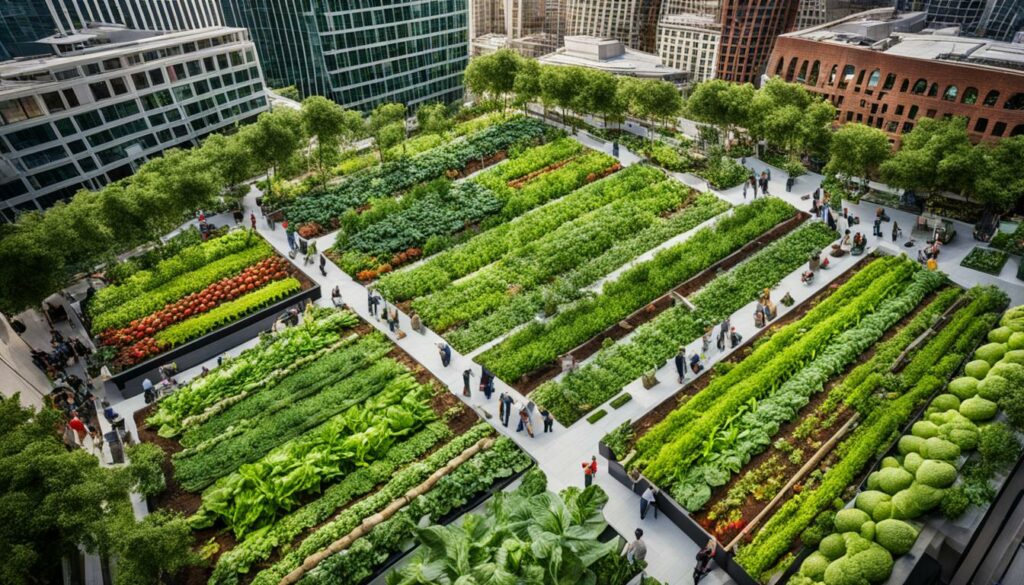
History shows us that ancient cities were already using ingenious ways to farm. Places like the Hanging Gardens of Babylon and Roman villa gardens used small spaces wisely. Detroit, in the 19th century, turned to urban farming during hard times. Schools started gardening, showing how important it was for the community.
The shift to industrial farming came in the 20th century, changing how we produce food. It focused on making lots of food fast, often harming the environment. But during the Great Depression, people turned to city gardens that provided millions in food value.
During World War II, the victory garden movement was born. It saw Americans grow lots of their own food, helping a lot during the war. Even with the success of large farms, issues led to a new look at older farming practices. By the 1980s, cities across the US had revitalised urban agriculture, helping production and community well-being. These actions started a wave of urban farming that continues now, praised for its impact on food security and community bonds.
Today, over 800 million people around the world practice urban agriculture. They can produce up to 50 kg of food per square metre each year. This form of farming not only remembers the past but also uses new techniques for a eco-friendly future. It has turned to nearly 67.4 million hectares of land today, playing a big role in feeding the planet.
Urban organic farming brings many environmental pluses. It changes our urban areas for the better. This farming style helps make cities greener and healthier.
One big win of urban organic farming is fighting the urban heat island effect. More green spaces in cities help reduce too much heat. This doesn’t just cool the area. It makes cities nicer places to live.
Better air is a major plus of urban organic farming. More plants means cleaner air. Changing from normal to organic foods can make a real difference. It can reduce harmful chemicals found in kids’ urine. This shows how green farming can really help the air we breathe.
City farms also help reduce stormwater problems. They use composting and avoid pesticides. This makes water run-off cleaner. It helps keep our water sources safe. Thus, it’s good for the whole city’s environment.
| Benefit | Impact |
|---|---|
| Reduction of Heat Island Effect | Cooling urban areas, enhancing livability |
| Improving Air Quality | Natural filtration, health benefits |
| Mitigating Stormwater Runoff | Reducing pollution, protecting water sources |
To sum up, urban organic farming is a win for us and the planet. It reconnects us with nature. Plus, it fights urban heat, cleans the air, and manages water better. By choosing these green ways, cities can become stronger and kinder to the Earth.
Urban organic farming has many different forms. Each form brings unique benefits to city life. These methods help in using space better. Also, they make communities closer and provide fresh, healthy food nearby.
Rooftop farms turn unused roof areas into growing space. They may use raised beds, greenhouses, or small animals, depending on the roof’s design. These gardens help wildlife, lower city heat, and save money on building heating.
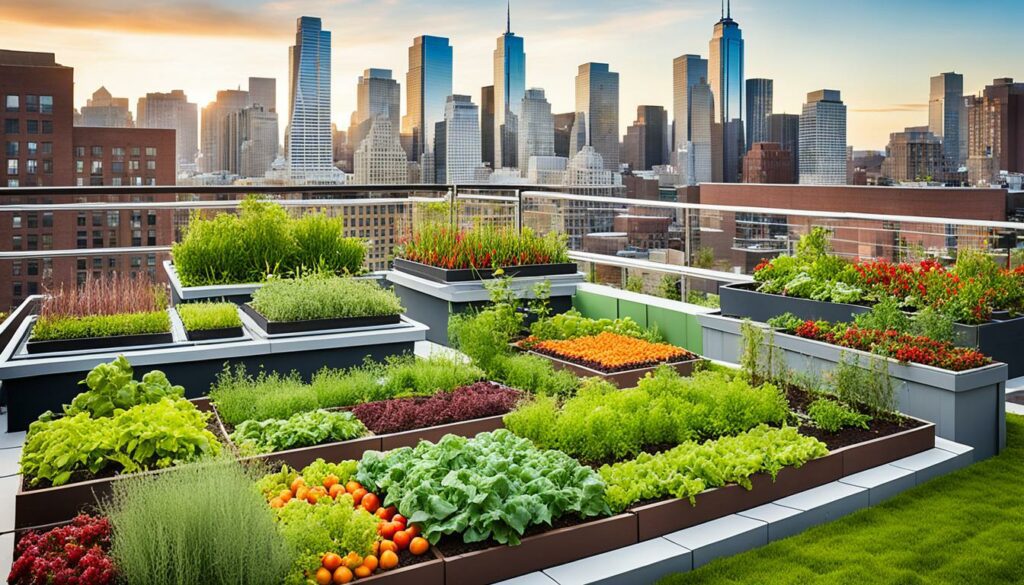
Community gardens are areas where people grow food together. They help cities by bringing people closer and offering fresh food. By working in these gardens, people learn and enjoy being in nature more.
Vertical farming grows food in stacked layers. It’s great for busy cities with little space. This kind of farming can be much more productive. It also uses less water and doesn’t need much soil.
| Type | Advantages | Challenges |
|---|---|---|
| Rooftop Gardens | – Uses wasted space – Helps keep buildings warm – Cools the city down | – Look at how much weight the roof can hold – Figuring out water use |
| Urban Community Gardens | – Makes people come together – Gives easy access to fresh food – Teaches new things | – Needs everyone to work together – Might get damaged |
| Vertical Farming | – Uses space very well – Saves water – Uses fewer chemicals | – Needs a lot of money at first – Relies on technology |
Each urban farm type is important for making our cities better places to live. They prove that growing food locally can help solve urban problems.
Urban agriculture is becoming more popular, changing how we produce food in cities. In the 50 biggest US cities, urban farms make up about 15% of all farms. They help save natural resources and boost local economies.
Urban farmers understand the importance of natural resource conservation. They use methods like aquaponics and hydroponics that need much less water than traditional farming. This helps save water and maintain productivity. Choosing organic farming means no harmful chemicals, which keeps the soil healthy and reduces health risks.
Urban farms play a key role in cutting down harmful chemicals. They use organic practices that are good for the environment. These methods keep the soil healthy and offer safer food. By changing policies, like offering tax breaks, cities can help urban farming grow. This change benefits the cities and the people in them.
Urban organic farming benefits both the economic sustainability and resilience of a community. It uses abandoned or underused urban areas. This boosts the local economy and brings people together.
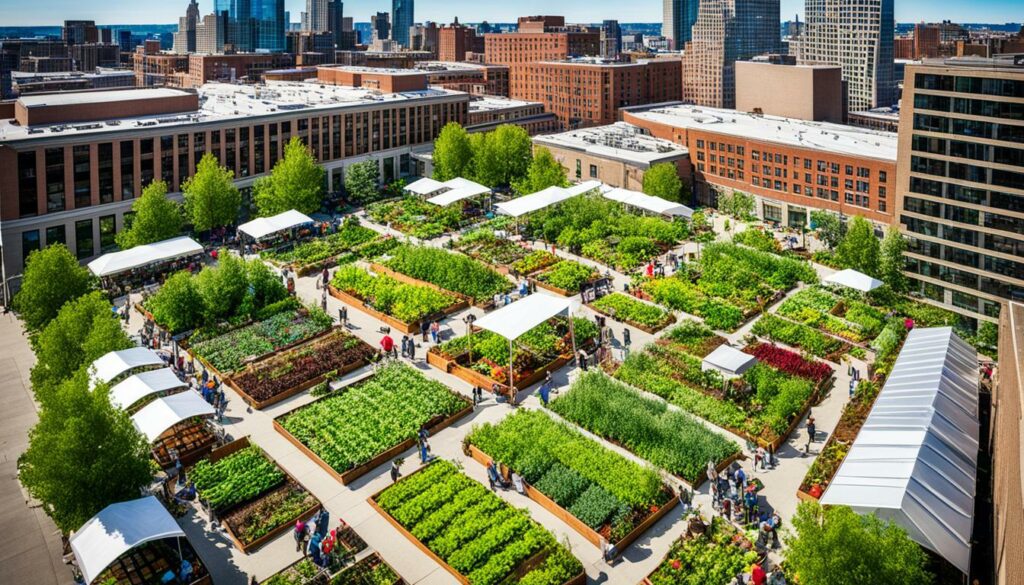
Investing in urban farming brings several economic advantages. For example, the biggest urban farm in Europe will open in Paris, covering about 14,000 square meters. It could produce 1,000 kg of fruit and veg daily at its peak. This not only increases food supply but also creates jobs. According to Cornell University, these farms can support themselves and bring financial safety. They also provide healthy food, helping with economic stability.
In cities like New York, farming in controlled environments has high-tech benefits. It uses new farming methods. These methods help local economies but face challenges in finding money and space for the farms to start.
Urban organic farming helps make communities stronger. It teaches farming and brings people together. Through farming, people learn, work, and connect with each other. This turns urban areas into places where strong social ties grow.
With about 68% of people moving to cities by 2050, farming in cities is more important than ever. It will help make sure cities have enough food, especially in places that are at risk. Using empty urban areas for farming can be a big help.
| Factor | Statistics | Impact on Community |
|---|---|---|
| Revitalisation of Urban Land | 14,000 sq meters urban farm in Paris | Enhanced food production, economic benefits |
| Population Migration | 68% of world’s population by 2050 | Pivotal role in ensuring food security in urban areas |
| Commercial Viability | Study by Cornell University | Financial security, employment, community beautification |
| Sustainable Practices | Controlled-environment agriculture in NYC | Innovative methods, though with higher energy footprint |
There are challenges, like expensive land and a lack of technical support. But, when the community works together, these obstacles can be overcome. This ensures that urban agriculture keeps helping the economy and the local community.
Cities are growing, making technology vital in urban organic farming. By 2050, about 68% of us will live in urban areas. So, we need smart farming tech to ensure there’s enough food safely and sustainably.
Urban farming is changing with methods like vertical farming and hydroponics. AeroFarms and Agricool use high-tech to use less water and grow more. AeroFarms needs 95% less water but produces 400 times more per square foot. Agricool saves 90% more water than usual farming does.
There are smart garden systems that make urban organic farming better. These systems use data to grow plants in the best conditions with less waste. Companies like Bowery Farming and Gotham Greens show that growing green things can be green for the planet too. Bowery Farming saves water and energy when growing leafy greens. Gotham Greens grows greens and herbs in greenhouses powered by wind and solar energy.
Technology in urban organic farming also helps solve old problems. Some small farms had to work very hard because they didn’t have the right tools or know about new ways. But with new farming tech, they can do better and grow more.
But, using high-tech for farming can have some downsides. For example, urban hydroponic farms can use a lot of energy. This can sometimes be a bigger problem than the good they do with more food and less water use. Plus, these new ways of farming can cost a lot at the start. This makes it hard to make money right away. Still, tech and new plant technologies offer hope for future farming that’s both profitable and good for the planet.
| Company | Innovative Technique | Water Usage Reduction | Energy Efficiency |
|---|---|---|---|
| AeroFarms | Vertical Farming | 95% | High |
| Agricool | Hydroponics | 90% | Moderate |
| Bowery Farming | Smart Garden Systems | Minimal | High |
| Gotham Greens | Greenhouses | – | Powered by Wind & Solar |
Looking ahead, new agricultural tech will change urban farming. It will make cities more self-sufficient and sustainable. This means urban areas could grow lots of healthy, fresh food.
Urban gardening is key in boosting social sustainability and offering many health benefits of gardening. Residents who join urban community gardens find improvement in their mind and body. They also feel more linked with their community. Urban agriculture creates chances for people to meet, keep their culture alive, and work together for a green future.
Being part of a home or community garden often leads to more urban community engagement. This activity makes people more active and brings them closer to fresh food. It makes their diet better. About 13% of folks in the United States worry about having enough food. Urban garden projects help lower food costs and give them better access to healthy food.
Michelle Howarth’s review looked at 77 studies and found that gardening has many health benefits. This proves it’s good for you. Kids who join gardening projects spend more time moving around, making them healthier from a young age.
Urban gardening helps everyone, not just the gardeners. They swap tips and food. This sharing includes special food and cooking ways. It makes their community stronger. Their actions also support urban community engagement and aims for a greener planet.
Studying urban farming shows four big benefits for communities: better health, a greener world, a richer social and cultural life, and more jobs and growth. Having a community garden nearby makes people feel safer and cuts down on crime. This shows how urban gardening positively affects society.
Urban organic farming has its fair share of hurdles. Things like not enough space, dirty soil, and water problems are big issues. But, by being creative and using new ways, we can find solutions. Good management is also key to make these farms last and do well.
More and more people want organic food each year. Unfortunately, only a tiny part of farm fields is actually used to grow organic things. This is where smart methods like rooftop gardens and vertical farms come in. They let farmers use every bit of space they have in cities.
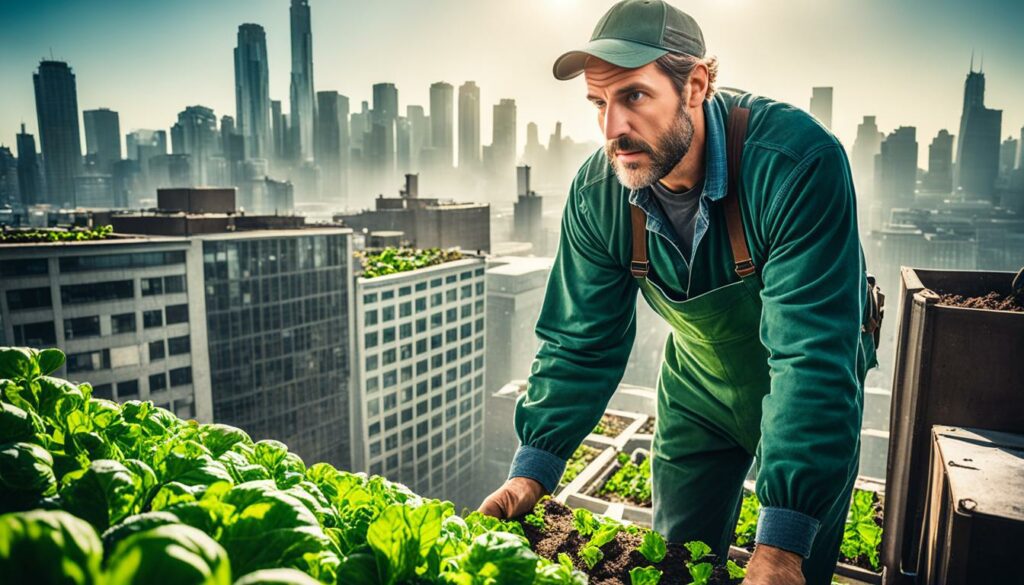
Dirty soil from GE crops is a major concern. Many organic farmers have found their fields were contaminated. To fix this issue, they must test the soil often. They also use compost and cover crops. These things make the soil healthier and safer for growing food.
Getting enough clean water can also be tough in cities. This is a problem for growing organic food. But, by reusing water, farms can save a lot. Water recycling systems are a great help. They make sure there’s always enough water for the crops.
How the urban farm is managed can make or break its success. Knowing and following the city’s rules is very important for the farmers. Keeping things in order helps them use the space well. It also makes sure their farms are a good part of the city.
Using new farming techniques can really change things. Hydroponics and aquaponics let people grow food in tiny places without using too much water. Community gardens and city farming bring fresh food to more people. They also teach about farming and bring the community together.
Helping new organic farmers with tax breaks and support for getting certified is a smart move. It makes doing urban farming a bit easier. And, having laws to protect farmers from GE crops is a big help. These steps keep urban farming going strong.
By finding the right answers to these tough questions, urban organic farming can thrive. This not only helps with having enough food but also makes cities more sustainable.
Urban organic farming boosts food security by rejuvenating local food systems. It reduces the need for imported goods. In the United States, a 2015 USDA report noted 39.4 million face low income and struggle to get nutritious, affordable food. Urban farming helps by making food locally, thereby improving the food supply chain and cutting down on the pollution from transporting far-off goods.
Urban organic farming revitalises local food systems, making them stronger and more sustainable. In cities, reaching the nearest store can be miles away. Locally produced organic food helps fill this gap. For example, in Detroit, urban farmers are turning city plots into farms. They’re using compost worth up to $10,000 each year. This way, they not only bring fresh food closer but also reduce the time it takes for food to get to people.
Urban organic farming helps in relying less on food from far away. This means we aren’t as dependent on food that’s shipped in. It’s key for community sustainability. For instance, in Baltimore City, more people are joining a course to learn about growing their own vegetables. Also, projects in Maryland show how using local water sources can make farming more sustainable. This helps to make food security stronger.
In essence, urban organic farming plays a big role in making sure we have enough food. It improves local food systems and cuts down on the need for imported food. These efforts move us towards an urban life that is more self-supporting and better for everyone’s health and wellbeing.
Studying successful organic farms in the city shows us the big potential of urban farming. They show how cities can turn into places for growing food in creative ways. We will look at some well-known urban farms globally to see what we can learn from them.
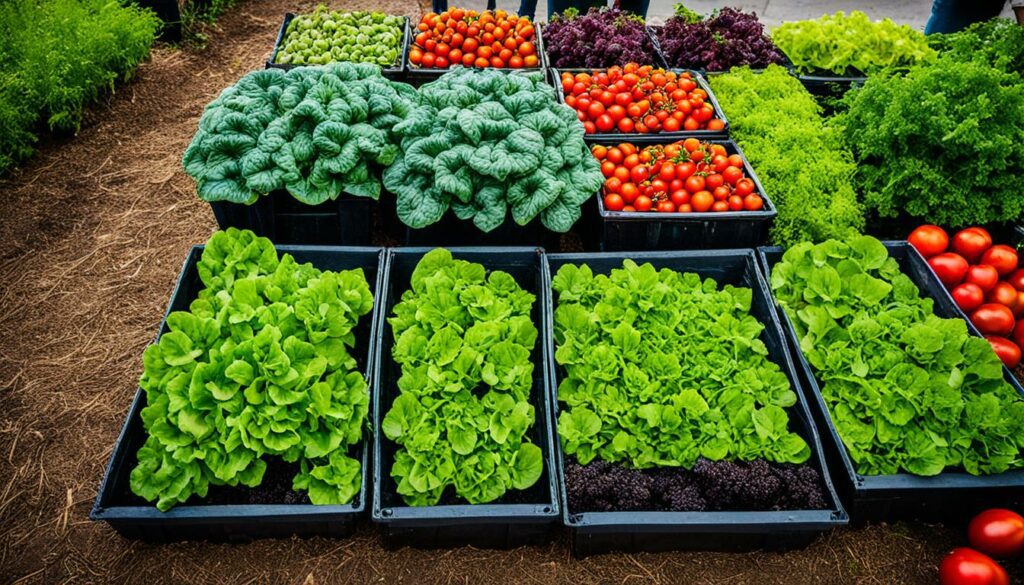
Urban farming is happening all over, involving around 800 million people. It covers more than 67 million hectares of land for growing crops. In places still developing, 266 million homes are growing crops in the city. This shows how these farming methods really work for a lot of people.
Cuba is a shining example of urban farming success. After 1989 when the Soviet Union broke up, it couldn’t import as much food. To cope, it turned a lot of its land in Havana – about 35,000 hectares – into farms. Soon after, more than half of the city’s fruits and veggies came from within the city. This was a smart solution to a big problem, thanks to urban farming.
City farms can be very productive, especially when growing fruits and vegetables that can reach up to 50 kg/m2/year. They also grow things like rice, wheat, and maize well. This high output is because the farms in cities can have several crops in the same area in a year.
In cities not as crowded, like smaller and medium-sized ones, urban farming can do even better. They have more open land where more can be grown. This helps the whole urban farming effort be more productive.
The table below shows some important numbers about urban farming around the world:
| Statistic | Global Impact |
|---|---|
| People engaged in urban agriculture | 800 million |
| Total urban cropland area | 67 million hectares |
| Households engaged in urban crop production in developing countries | 266 million |
| Yield for urban fruit and vegetable cultivation | Up to 50 kg/m2/year |
| Irrigated urban cropland | 23.6 million hectares |
| Rain-fed urban cropland | 43.8 million hectares |
| Primary urban crops | Rice, Wheat, Maize, Fodder grasses |
These urban farming case studies show us how cities can transform with agriculture. By using successful farming models that fit their own situations, cities all over can improve how secure they are with food. They can also help the environment more and make their communities stronger.
Looking into the future of farming in cities, we face big challenges. The climate is changing fast and cities are getting bigger. We’ve already made a lot of progress in urban farming, covering more than 67 million hectares worldwide. But, the future success of this type of farming depends on our ability to grow and change with the climate.
Climate change has hit farming hard, making the weather unpredictable and reducing crops. Urban farming helps fight back. It can produce up to 50 kg of food per square metre each year. This is crucial as the traditional way of farming can’t keep up with the world’s growing population.
Using smart technology like automated irrigation and sensors can help us use resources better. This is important in a world where climate change is making resources like water scarce.
To make sure our cities have enough food, we must make urban farming even bigger. About 800 million people are already involved in urban farming. They live in 266 million homes in developing countries. But, there’s room to grow more.
We can use technologies like vertical farming, hydroponics, and aquaponics to farm in small spaces. This helps a lot in cities that are very crowded. Small towns can even do better in growing food than big cities sometimes.
Working together, we can build communities that grow their food. We can share gardens and teach people how to farm in sustainable ways. This not only helps fight climate change now. It also makes sure we can feed ourselves in the future.
| Aspect | Current Status | Future Goals |
|---|---|---|
| Global Urban Cropland | 67.4 million hectares | – |
| Irregular Cropland | 23.6 million hectares | – |
| Rain-fed Cropland | 43.8 million hectares | – |
| Per-Capita Cropland Area | 300 sqm in developed countries, | Increase in developing regions |
| Farmers’ Crop Rotations per Year | Higher than overall average | – |
| Urban Farmers | 800 million people | Expand engagement |
We must match our farming methods with the challenges of climate change and the need to grow more food. This is key to a safe and stable future for food.
Setting up an urban farm can be a very rewarding project. It’s becoming more popular as people aim to grow their own food in cities. It’s important to understand what you need and how to ensure your farm lasts.
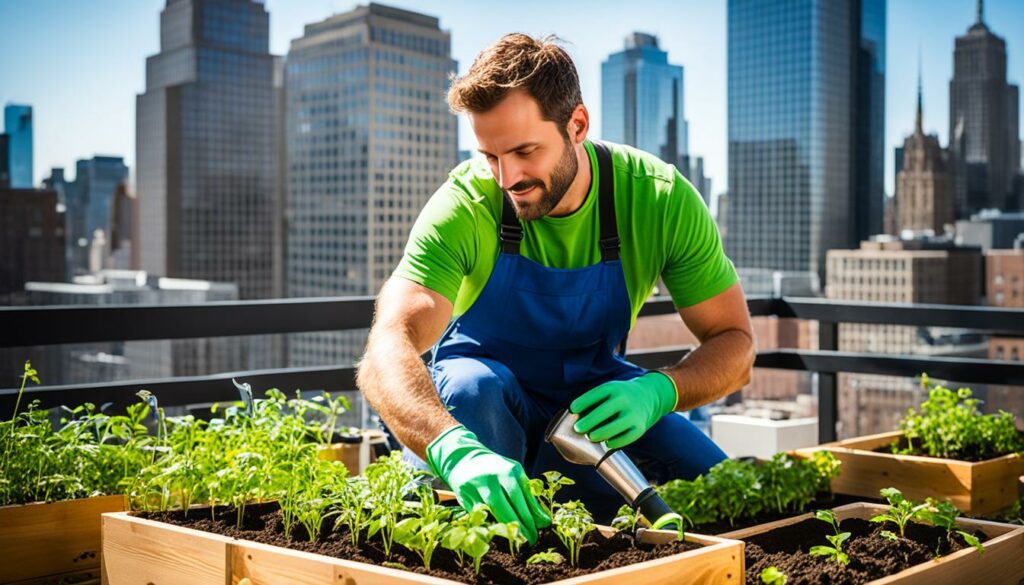
Start your urban organic farm journey by planning well. Pick the right spot by looking at things like how much sunlight the area gets, how much space you have, and if there’s water nearby. Testing the soil is a must. If it needs help, add organic materials to make it right for growing.
After that, choose which farming method works best for you and your goals. For example, vertical farming lets you grow more food in the same space. Or you might try hydroponics, a method that saves a lot of water compared to traditional farming.
It’s also key to connect with others in the farming community. Join groups and meet with like-minded people. The National Federation of Independent Business (NFIB) is one place that can help, offering resources and chances to meet others.
Don’t forget about new farming ideas like aquaponics and using shipping containers. These methods do well in small areas and can provide a steady income. Meeting other urban farmers can help you learn and share ideas for facing challenges.
| Urban Farming Technique | Benefits |
|---|---|
| Vertical Farming | Increases food production efficiency by up to 400% using stacked layers. |
| Hydroponics | Reduces water usage, requiring only 70 liters to grow the same amount of tomatoes traditional methods need 400 liters for. |
| Aquaponics | Creates a symbiotic relationship between fish and plants, benefiting both. |
| Shipping Container Farms | Can be operated in limited spaces and generate a full-time income. |
So, starting an urban farm is about good planning and choosing the right methods. It’s also about connecting with others in the farming community. This way, urban farmers can make a real difference in sustainable city living.
Urban organic farming is changing city areas. It’s turning them into lively gardens that help an organic way of living and community health. This change is bringing environmental and social gains to many. Between 15% and 20% of food worldwide is now grown in or near cities (Abdulkadir et al., 2012), showing these projects’ huge potential.
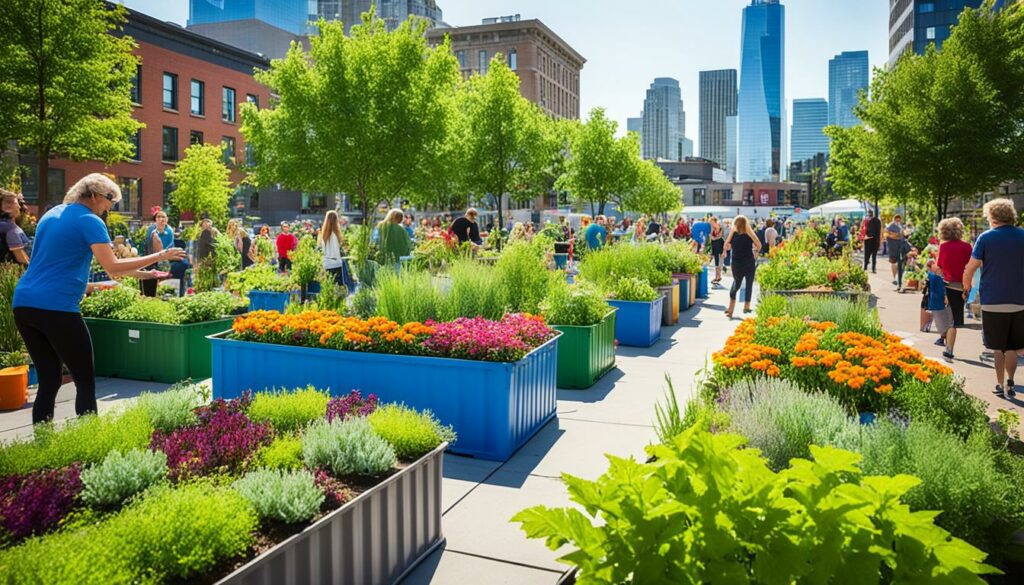
People are getting involved in city farming. Over 17,000 folks have been part of our farming events and learning sessions. These times not only educate but also unite people, showing the power of organic farming to impact our happiness and wellbeing.
Our city farms are really productive, too. They can grow up to 10,000 kg of fruits and vegetables a year. This is a big plus for local food supplies. Also, about 2,060 litres of waste are turned into compost each year. This keeps waste out of dumps, leading to a cleaner cycle of life in our cities.
Sponsoring local farmers helps keep the organic way of life going strong, benefiting the whole community. This support plays a key role in making our cities greener and more liveable for everyone.
Urban organic farming is tackling big city problems. It’s easing issues like obesity, poverty, and not having enough to eat. Take Hartford, where 34% of adults were obese in 2000, twice the state’s average. Urban farming can make fresh, nutritious food more available, supporting local economies.
Looking ahead, these urban farming projects are key in building cities that thrive sustainably. By backing urban organic farming, we are weaving green living into our cities’ fabric. This helps both the environment and the people who call cities home.
Urban organic farming is changing how we live in cities and think about agriculture. It is key as more people move to urban areas. By 2050, almost 68% of the world’s population will likely live in cities. Such farming enhances our health and the environment, builds strong social connections, and boosts the economy.
Growing food in cities offers many perks. It can lower food costs and improve access to healthy foods. Also, it helps during crises like pandemics by providing local food. Plus, farming activities are good for physical and mental health and help the environment in various ways.
Nevertheless, there are issues to overcome, like bad soil and city contaminants. For the safety of growers, health precautions are necessary. Despite these issues, urban farming boosts social ties, community spirit, and safety, especially for immigrants through community gardens.
Supporting urban farming is an investment in our future. It benefits our environment, future generations, and our community. The future of farming in cities is hopeful, offering sustainable living solutions. Embracing urban organic farming is crucial in tackling worldwide problems like food shortage, climate change, and rapid urban growth.
Urban organic farming is about growing food in cities. It uses eco-friendly ways without harmful chemicals. This method aims to keep the environment healthy.
It helps by saving natural resources and keeping the environment clean. By using less chemicals, it also creates areas in cities that stay cool.
Some popular methods are rooftop gardens, community plots, and vertical farms. They make good use of small city spaces and bring people together.
It cools down cities, cleans the air, and manages rainwater better. This makes the city a healthier place to live in.
It provides local jobs and supports farming that is good for the community. It also helps people learn and work together, making the community stronger.
Technology is used to farm better in cities. It helps make the most of small spaces and keeps the farming methods eco-friendly.
Urban gardening is good for health, reduces stress, and brings people together. It makes cities more enjoyable places to be.
There are issues like finding space, clean soil, and enough water. But, using space well, cleaning soil, and recycling water can solve these problems.
It makes local food systems stronger and less reliant on food from far away. This helps keep food available and fresh for people in the city.
There are many successful urban farms across the globe. They show that these projects can work well in different cities.
As climate problems grow, the demand for such farming will rise. Making urban farming bigger and stronger to face these changes is very important.
Start by planning and getting help from others. Think about where and how you’ll grow food. Getting your community involved is key to success.
It turns city areas into green, productive places. This not only makes cities prettier but also promotes better health and community living.